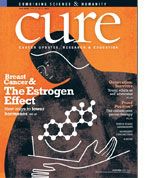Publication
Article
CURE
Drugs First, Surgery Later?
Author(s):
Neoadjuvant breast cancer therapy may be beneficial.
There’s a rush to surgery in what is actually a very chronic illness,” says Matthew Ellis, MD, PhD, of Washington University in St. Louis. Instead, Ellis advocates treating patients with hormone therapy prior to surgery (neoadjuvant therapy) to see if they respond before deciding on a treatment course. “We need to educate surgeons and patients that it’s not in their best interest to remove the tumor the moment the patient comes into the office,” he says.
Studies suggest that this approach is equivalent in terms of risk of recurrence, but may offer other advantages. For one, patients whose tumors respond well to hormone therapy could opt for more conservative surgeries. In a recent study led by Ellis, half of women initially told that they were ineligible for breast-conserving surgery underwent the procedure after their tumors shrank in response to pre-surgery treatment with an aromatase inhibitor.
Avoiding toxic chemotherapy in patients who don’t need it is another plus. “If you take out the tumor first,” Ellis says, “then the patient is destined to receive non-specific therapy, including chemotherapy or radiation, that they may not need.”
Gabriel Hortobagyi, MD, at M.D. Anderson Cancer Center in Houston, agrees that this is a worthy goal but doesn’t feel that the trials on neoadjuvant hormone therapy have generated sufficient data to justify eliminating chemotherapy in many cases. He points out that patients with larger tumors are increasingly treated with chemotherapy prior to surgery—a strategy that may also allow for more breast-conserving surgeries. “We need to develop better predictors of chemotherapy and endocrine therapy benefits to make the choice of initial therapy easier,” he says.
Neoadjuvant studies will also provide valuable tumor tissue for genetic analysis by allowing multiple opportunities to sample tissue, which will help reveal the biology behind hormone resistance. Using this information, Ellis sees the field moving toward more individualized treatments. “If we can diagnose an endocrine-resistant tumor quite quickly,” he says, “we have a window of time to do genomic analysis, so we can start to develop genome-matched therapies for individual patients.”





